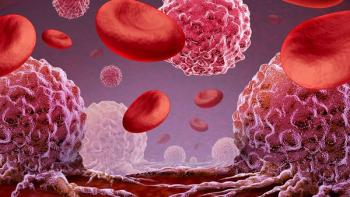
Ninlaro-Darzalex Combo Elicits Favorable Treatment Outcomes, Responses in Newly Diagnosed Multiple Myeloma
Treatment with Ninlaro plus Darzalex and a low dose of the steroid dexamethasone was associated with favorable responses to treatment in non-transplant eligible, intermediate-fit patients with newly diagnosed multiple myeloma.
The use of Ninlaro (ixazomib), Darzalex (daratumumab), and a low-dose of the steroid dexamethasone was effective in treating a group of non-transplant eligible, intermediate-fit patients with newly diagnosed multiple myeloma (NDMM), according to recent study results.
In the single-arm study, which was designed to explore the potential for a less-toxic regimen for intermediate-fit patients with NDMM, there were clinically significant improvements seen in global health status, role functioning and future perspective from baseline to the end of the induction regimen with the triplet therapy; however, there was also a worsening of clinically significant polyneuropathy (damage to many nerves that causes weakness, numbness or pain in the body).
Overall, 46% of patients did not proceed to maintenance therapy after induction, primarily due to progressive disease (63%) and toxicity (13%).
“We think that maybe it is important to combine immune therapy with (immunomodulatory drugs), and maybe look into whether T cell-directed therapy is feasible in intermediate patients," lead study author Dr. Kaz Groen, of Amsterdam UMC, Vrije Universiteit Amsterdam, Cancer Center Amsterdam, said during a presentation of the findings at the 2021 ASH Annual Meeting. “It's important to keep in mind that we need agents with less toxicity, especially neurotoxicity. Low-grade neurotoxicity is what commonly leads to discontinuation of treatment.”
International Myeloma Working Group Frailty Index (IMWF-FI) intermediate-fit patients comprise one-third of new diagnoses of non-transplant eligible multiple myeloma. Of note, the IMWF-FI is a system that scores individuals, on a range from 0 to 5, based on several factors including age and presence of comorbidities and determines if patients are either fit, intermediate-fit or frail.
When compared with fit patients, intermediate fitness is associated with inferior overall survival (the time from the start of treatment when a patient with cancer is still alive) and higher treatment discontinuation due to toxicity, which prompted the conduct of the trial, Groen noted.
In the phase 2 HOVON 143 study, 65 patients with NDMM were treated with Ninlaro, Darzalex, and dexamethasone in nine four-week induction cycles. For the study, Ninlaro was administered at 4 mg on days 1, 8, and 15 along with 16-mg/kg of Darzalex on days 1, 8, 15, and 22 of cycles one and two, days 1 and 15 of cycles three to six, and then on day one only for cycles seven to nine. Additionally, patients received dexamethasone on the same days as Darzalex at 20 mg for cycles one and two followed by 10 mg for cycles three to nine. Following induction, maintenance therapy consisted of Ninlaro at 4 mg on days 1, 8, 15, 29, 36, and 43 of an eight-week cycle along with Darzalex at 16 mg/kg and dexamethasone at 10 mg on day one for up to two years. The antibiotic cotrimoxazole and antiviral valaciclovir were also administered, to avoid infections.
“After induction, just over half of patients received maintenance. This was mostly due to progressive disease in two-thirds of cases but also partially to toxicity or noncompliance,” said Groen. “Seven patients, or 11%, discontinued (Ninlaro) alone during treatment, which means they were only treated with (Darzalex) and dexamethasone.”
The median age of patients enrolled was 76 years (range, 65 to 80), with most being between 76 and 80 years of age (57%). At the start of the trial, all patients had an activity of daily living (ADL) score of five or greater. An ADL score identifies a patient’s independence in performing daily tasks such as going to the bathroom and eating. A score of four represents someone who is independent while a score of 18 means they are totally dependent on others for assistance.
Most patients had stage 2 disease (57%), with 18% having stage 3 and 25% having stage 1.
Treatment with Ninlaro, Darzalex and dexamethasone induced an overall response rate, which is the percentage of people whose disease partially or completely responds to therapy, of 71%. The responses consisted primarily of very good partial responses (23 patients; 35%) and partial responses (22 patients; 34%). There was one complete response (2%). Additionally, there was a minimal response in 17% of patients and stable disease in 11%. One patient was not evaluable.
At a median follow up of 18.1 months (range, 9.4 to 27.8 months), the median progression-free survival (time during and after treatment a patient lives without disease progression) was 17.4 months. There was no difference in progression-free survival (PFS) for those deemed less likely to be fit because of age, Groen noted. The median PFS for those deemed to have intermediate fitness due to age was 16.6 months.
The median overall survival was not yet reached. There had been eight deaths at the time of the analysis. The median event-free survival, or the length of time after treatment ends that a patient remains free of certain complications or events the treatment was supposed to prevent or delay, was 5.3 months.
Overall, 51% of patients experienced a serious or severe non-blood related side effect with the combination. The most common ones included gastrointestinal events (36%) and infections (37%). Peripheral neuropathy of all severities was experienced by 41% of patients.
A version of this article was originally published on OncLive as, “
For more news on cancer updates, research and education, don’t forget to





